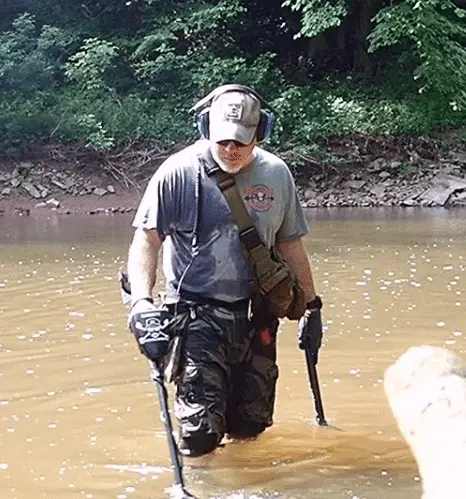Underwater Metal Detecting is a lot of fun. But what kind of underwater gear do you need to get started? I’ve been metal detecting underwater for almost 6 years and I know a lot about the gear and the essential gear you need to get started. In this article I’m going to go over 10 essential items you need for for underwater metal detecting.
But first, the underwater detecting I’m referring to in this article will be mostly associated with river or stream metal detecting. Beach and lake metal detecting is a little different and I’ll cover both of them in future articles. For now, here are 10 items [Essential Gear] for underwater metal detecting in a river or stream.
1. A Waterproof Metal Detector.
Make sure your metal detector is 100% waterproof before submerging it underwater.
The most important piece of underwater metal detecting gear is obviously your metal detector. If you are considering going underwater with your machine you need to make sure it is waterproof. Most machines are only waterproof from the coil up to the control box. However there a number of machines out there that are 100% submersible down to just about 10 feet or so. Call your dealer if you aren’t sure about your machine. I’ve been using the Garrett AT Pro as my go-to water machine for many years and it has served me well. Here are a few others I know that are completely submersible:
What is The Best Underwater Metal Detector – Fresh Water?
I personally love the Garrett AT Series Detectors. They have been proven to be some of the best machines for fresh water (rivers, streams, and lakes). With that said, I own the AT Pro but the AT Gold has better/clearer tones. However, all of the metal detectors below are 100% waterproof and very popular. These underwater metal detectors are VLF detectors. They are not “Pulse Induction” also known as “PI” machines. I will write more about pulse machines in a future article. VLF metal detectors are more common and used more often in rivers and streams. Click on links below to get price comparisons on Amazon.
Most Popular Underwater Metal Detectors For Fresh Water Hunting:
- Garrett AT PRO
- Garrett AT Gold
- Garrett AT Max
- MinelabEquinox 600 or 800
- Minelab CTX 3030
- Whites MX Sport
- Fisher CZ21
- Fisher 1280-X
One thing I will add about these waterproof machines and the coil options, the smaller coils seem to work better because they are easy to maneuver and swing through the water. The bigger the coil, the harder it is to move. Plus having a large coils makes it difficult getting down in some of those cracks. Rule of thumb the small the coil the better. On the Garrett Series of machines, I use the 5″x 8″ DD coil and it works really well.
2. Waterproof Headphones.
The 2nd most important piece of underwater metal detecting gear you will need is a good set of waterproof headphones. If your metal detector is 100% waterproof it probably didn’t come with waterproof headphones unless they came as a package deal. Depending on the make and model of your machine you can purchase aftermarket headphones that are waterproof. I recommend sticking with the waterproof headphones that have great reviews and have been tested over time. Here are some very popular headphones that many underwater metal detector enthusiasts purchase. Again, I’ll include the Amazon links so you can check prices but please make sure you get the proper headphones that fit your metal detector.
Most Popular Waterproof Headphones Available Through Amazon.
Garrett Submersible Headphones (AT Pro, Gold, Max)
Minelab Equinox Waterproof Headphones
Minelab CTX 3030 Waterproof Headphones
Detector PRO Gray Ghost Water Headphones for The Whites MX Sport
Detector PRO Gray Ghost Amphibian II Waterproof Headphones for Garrett AT Pro/Gold and Infinium Detectors.
3. Buy a Pair of Boots That Fit Over Your Ankles.
The 3rd most important piece of metal detecting gear is a pair of boots that protect your ankles and shins. It is so important to protect your ankles on the sharp edgy rocks. You certainly don’t want to make a trip to the emergency room for stitches or even worse, you break your ankle.
Boot Hack: Use a staple gun and staple the bottom of your soles for better traction on the slippery rocks.
The wet rocks are extremely slippery. To get better traction on the rocks, I like to use a staple gun and staple the bottom of my boots (soles) with staples that don’t penetrate the sole of the boots but just go in deep enough that provide me better traction walking up and down the river. You will be amazed at how well this tip works.
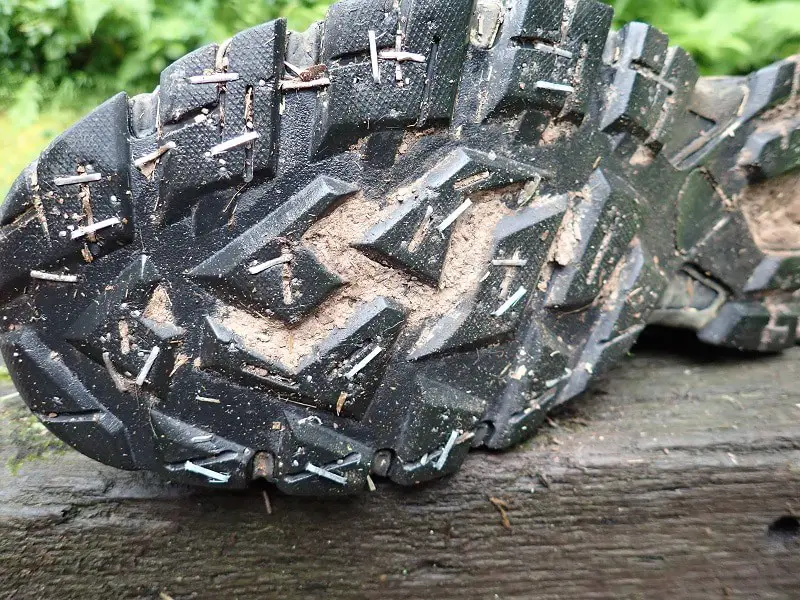
4. Get A Waterproof Pin-Pointer.
Another important piece of metal detecting gear you are probably going to want is a fully submersible and 100% waterproof pin-pointer. There are many to choose from these days and most work really well. I’ve used the Garrett Pro-Pointer also know as the “Garrett Carrot” for several years and I had good success with it. But recently, I’ve switched over an XP MI-4 and XP MI-6 Pro-Pointers. I really like how well these pin-pointers are made and the are rechargeable and if used correctly you can get up to 30 hours of use before needing a re-charge. I’ll include the most popular pin-pointers below along with their Amazon links.
Most Popular Waterproof Pinpointers.
Garrett Pro Pointer AT Waterproof Pinpointer (Garrett Carrot)
Minelab Pro-Find 35 Waterproof PinPointer
XP MI-4 Waterproof PinPointer
XP MI-6 Waterproof PinPointer
5. Wear A Pair of Rubber Coated Gloves.

Protect your hands. Always wear a pair of rubber coated gloves in the water.
Protect yourself from glass and sharp metal. The rivers are full of trash. I always wear a pair of rubber coated gloves when I metal detecting in the water. The rocks are sharp but so is the broken glass, shards of metal, nails, and even needles believe it or not.
6. Purchase a High Power Magnet.
This item is not essential but worth getting at some point. If you plan on digging the iron then I would highly recommend getting a high power magnet. A magnet that can pull over 100 lbs is what I would recommend. I have a magnet that is on the end of my river pick (more on that in the next section). I’ve seen people find cannon balls, and civil war era shells from underwater metal detecting. All I’ve ever found with mine is horse shoes and scrap iron. My search continues for a cannonball which is on my bucket list.
7. You Will Need a Shovel or Pick.
If you are digging the banks or prying up big rocks a river pick or shovel will be a lifesaver. Some of the rocks you are going to encounter will be too big to move. Having a shovel or pick may just give you enough leverage to move the rock out of the way and expose the treasure you are looking for. I carry 2 different types of picks. I purchased “The Hermit Pick” from Bunks Arizona Prospecting. A few years ago and I picked up the Garrett Retriever II which is a small handheld pick with a small high powered magnet. Both work well depending on the type of conditions you are faced with. I don’t think Garrett offers the Retriever II anymore. You can easily purchase your own here.
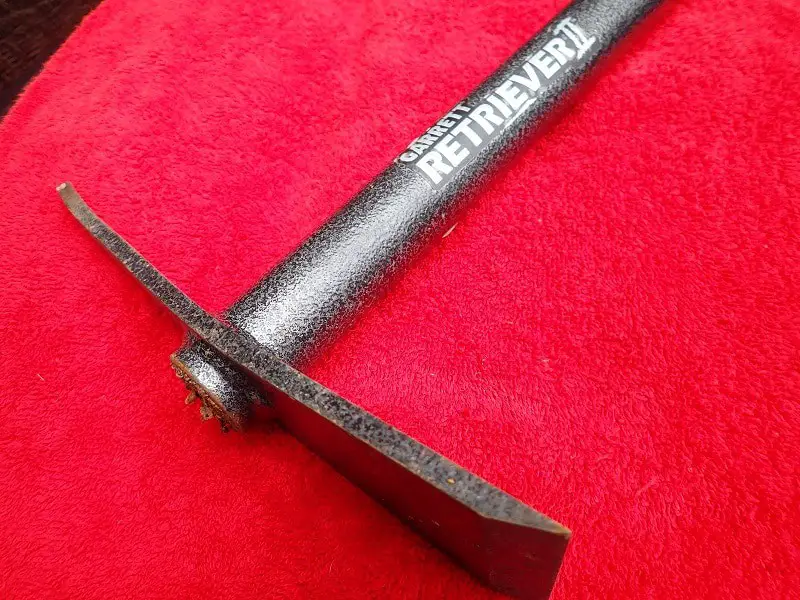
Small Pick (Hand Held) 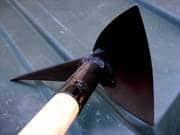
Hermit Pick
8. Tether Your Underwater Gear to Yourself.
Most people don’t think about tethering their gear to their belt or bag until they are already in the water and their metal detecting gear is already floating downstream. If you are in fast moving water your equipment could be lost before you realize its gone and in some cases it will be gone. I recommend tethering both your metal detector and your pin-pointer to your waste (belt) or bag. You will thank me later.
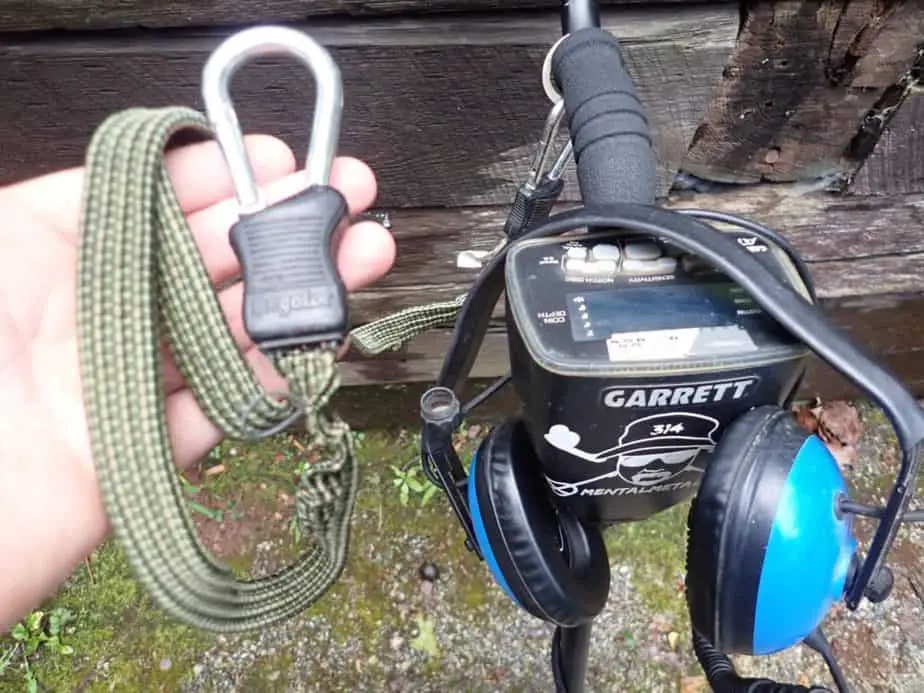
Machine Tether 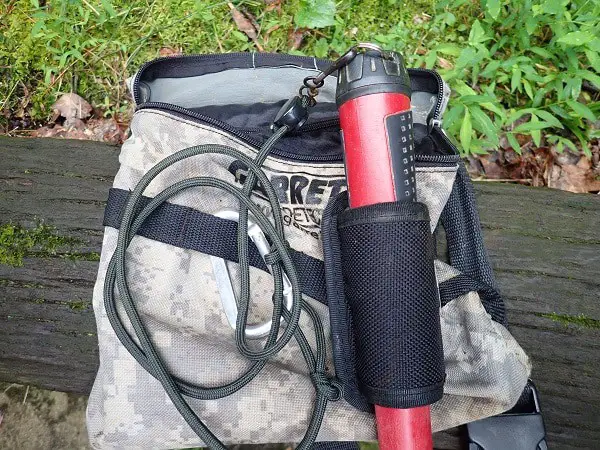
Pin-Pointer Tether
9. Protect Your Knees Underwater With Knee Pads.
Your knees are just as important as your feet when you are metal detecting underwater. As you bend down or kneel down in the water, your knees are going to take a beating unless you have a good set of knees pads that can protect your knees from the sharp rocks on the river bottom. One trip without them and you will know why you won’t forget them for the next adventure. Click here to see the pair I use.
10. Take Along a Bag or Metal Detecting Pouch To Hold Your Treasure (and trash).
What are you going to use to haul out your metal detecting treasure? Most people also take a long a bag or pouch to hold their treasure and trash. I use my bag to for that reason as well but I also use it hold my pin-pointer. I will tether my pin-pointer to my bag and the same goes with my metal detector. Your bag will come in handy for sure.
Bonus. Underwater Metal Detecting Bag Hack
Bag Hack: Heat up the tip of an old screwdriver and melt small holes in the bottom of your bag or pouch.
Here is a little trick or hack that most people don’t realize before its too late. Heat up the tip of an old screwdriver and melt small holes in the bottom of your bag or pouch. This will let the water flow through your bag and remove the buoyancy so you don’t have to worry about an air pocket that causes your pouch to float away with the current. After all you spent hours find all of your underwater loot. It would be a shame to find your bag empty at the end of your hunt.
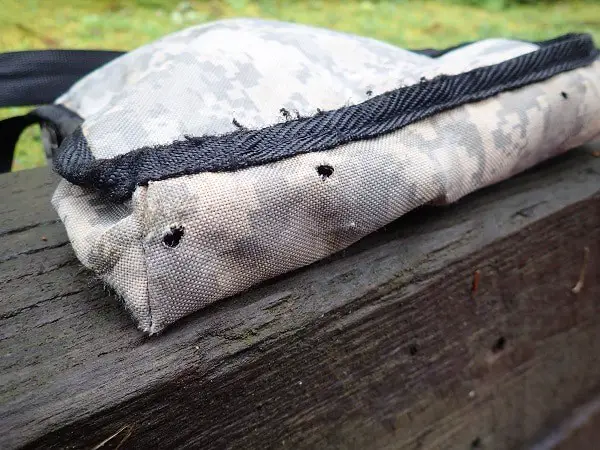
Hopefully my Underwater Metal Detecting Gear Guide will help you purchase exactly what you need to get started. I wish you all great success and hope you find something good in those rivers, streams, and lakes. The treasure is out there you just have to but your coil over it. Good luck and happy hunting.
Watch The Video For More Underwater Gear Tips.
The video link below is a video I put together a couple of years ago. In this video I go over all of my underwater metal detecting gear to include some additional underwater gear I didn’t mention in this article. Check it out below.
NOTE: Sections of this post contain affiliate links that allow you to find the items mentioned in this blog post and support the site at no cost to you. While this site may earn minimal sums when the reader uses the links, the reader is in NO WAY obligated to use these links. Thank you for your support!

